Leadership Commentary: Authentic Leadership & Knowledge Economy
VerifiedAdded on 2023/06/18
|17
|3454
|399
Report
AI Summary
This report provides a commentary on leadership, focusing on transformational and authentic leadership styles. It analyzes two articles: one on emotional intelligence and transformational leadership in virtual teams, highlighting the shift to virtual teams and the importance of effective virtual leadership, and the other on authentic leadership and the knowledge economy, emphasizing the significance of sincerity, self-awareness, and open-mindedness in leaders to foster trust and motivation among knowledge workers. The report underscores how authentic leaders prioritize organizational goals, connect with their staff, and focus on long-term value, suggesting that organizations should implement various authentic leadership theories and styles for the betterment of their workforce. The analysis includes references to leadership in virtual teams and limitations related to sample usage, advocating for future research with diverse groups and complex problem-solving scenarios. Desklib provides a platform for students to access similar solved assignments and past papers.
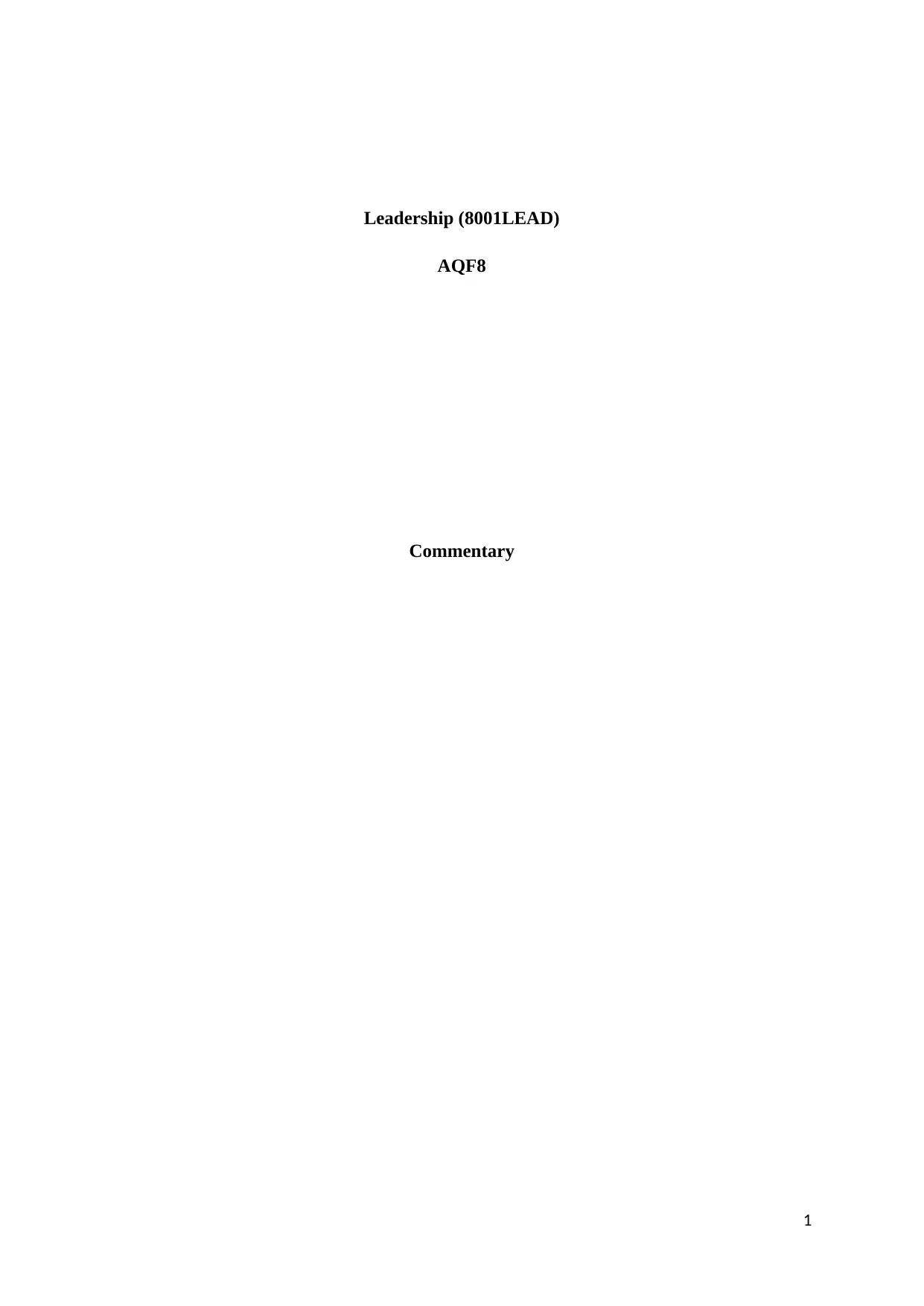
Leadership (8001LEAD)
AQF8
Commentary
1
AQF8
Commentary
1
Paraphrase This Document
Need a fresh take? Get an instant paraphrase of this document with our AI Paraphraser
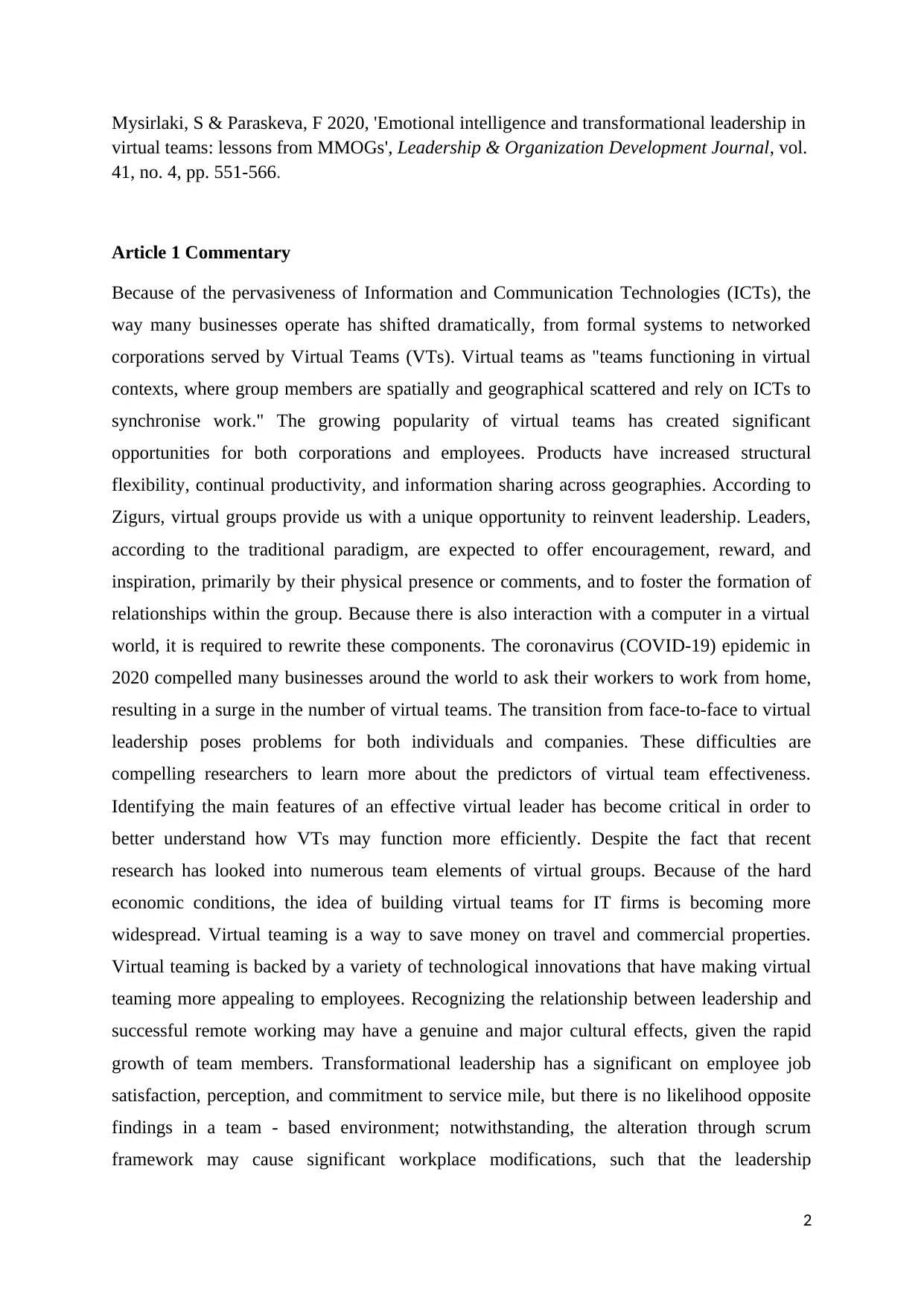
Mysirlaki, S & Paraskeva, F 2020, 'Emotional intelligence and transformational leadership in
virtual teams: lessons from MMOGs', Leadership & Organization Development Journal, vol.
41, no. 4, pp. 551-566.
Article 1 Commentary
Because of the pervasiveness of Information and Communication Technologies (ICTs), the
way many businesses operate has shifted dramatically, from formal systems to networked
corporations served by Virtual Teams (VTs). Virtual teams as "teams functioning in virtual
contexts, where group members are spatially and geographical scattered and rely on ICTs to
synchronise work." The growing popularity of virtual teams has created significant
opportunities for both corporations and employees. Products have increased structural
flexibility, continual productivity, and information sharing across geographies. According to
Zigurs, virtual groups provide us with a unique opportunity to reinvent leadership. Leaders,
according to the traditional paradigm, are expected to offer encouragement, reward, and
inspiration, primarily by their physical presence or comments, and to foster the formation of
relationships within the group. Because there is also interaction with a computer in a virtual
world, it is required to rewrite these components. The coronavirus (COVID-19) epidemic in
2020 compelled many businesses around the world to ask their workers to work from home,
resulting in a surge in the number of virtual teams. The transition from face-to-face to virtual
leadership poses problems for both individuals and companies. These difficulties are
compelling researchers to learn more about the predictors of virtual team effectiveness.
Identifying the main features of an effective virtual leader has become critical in order to
better understand how VTs may function more efficiently. Despite the fact that recent
research has looked into numerous team elements of virtual groups. Because of the hard
economic conditions, the idea of building virtual teams for IT firms is becoming more
widespread. Virtual teaming is a way to save money on travel and commercial properties.
Virtual teaming is backed by a variety of technological innovations that have making virtual
teaming more appealing to employees. Recognizing the relationship between leadership and
successful remote working may have a genuine and major cultural effects, given the rapid
growth of team members. Transformational leadership has a significant on employee job
satisfaction, perception, and commitment to service mile, but there is no likelihood opposite
findings in a team - based environment; notwithstanding, the alteration through scrum
framework may cause significant workplace modifications, such that the leadership
2
virtual teams: lessons from MMOGs', Leadership & Organization Development Journal, vol.
41, no. 4, pp. 551-566.
Article 1 Commentary
Because of the pervasiveness of Information and Communication Technologies (ICTs), the
way many businesses operate has shifted dramatically, from formal systems to networked
corporations served by Virtual Teams (VTs). Virtual teams as "teams functioning in virtual
contexts, where group members are spatially and geographical scattered and rely on ICTs to
synchronise work." The growing popularity of virtual teams has created significant
opportunities for both corporations and employees. Products have increased structural
flexibility, continual productivity, and information sharing across geographies. According to
Zigurs, virtual groups provide us with a unique opportunity to reinvent leadership. Leaders,
according to the traditional paradigm, are expected to offer encouragement, reward, and
inspiration, primarily by their physical presence or comments, and to foster the formation of
relationships within the group. Because there is also interaction with a computer in a virtual
world, it is required to rewrite these components. The coronavirus (COVID-19) epidemic in
2020 compelled many businesses around the world to ask their workers to work from home,
resulting in a surge in the number of virtual teams. The transition from face-to-face to virtual
leadership poses problems for both individuals and companies. These difficulties are
compelling researchers to learn more about the predictors of virtual team effectiveness.
Identifying the main features of an effective virtual leader has become critical in order to
better understand how VTs may function more efficiently. Despite the fact that recent
research has looked into numerous team elements of virtual groups. Because of the hard
economic conditions, the idea of building virtual teams for IT firms is becoming more
widespread. Virtual teaming is a way to save money on travel and commercial properties.
Virtual teaming is backed by a variety of technological innovations that have making virtual
teaming more appealing to employees. Recognizing the relationship between leadership and
successful remote working may have a genuine and major cultural effects, given the rapid
growth of team members. Transformational leadership has a significant on employee job
satisfaction, perception, and commitment to service mile, but there is no likelihood opposite
findings in a team - based environment; notwithstanding, the alteration through scrum
framework may cause significant workplace modifications, such that the leadership
2
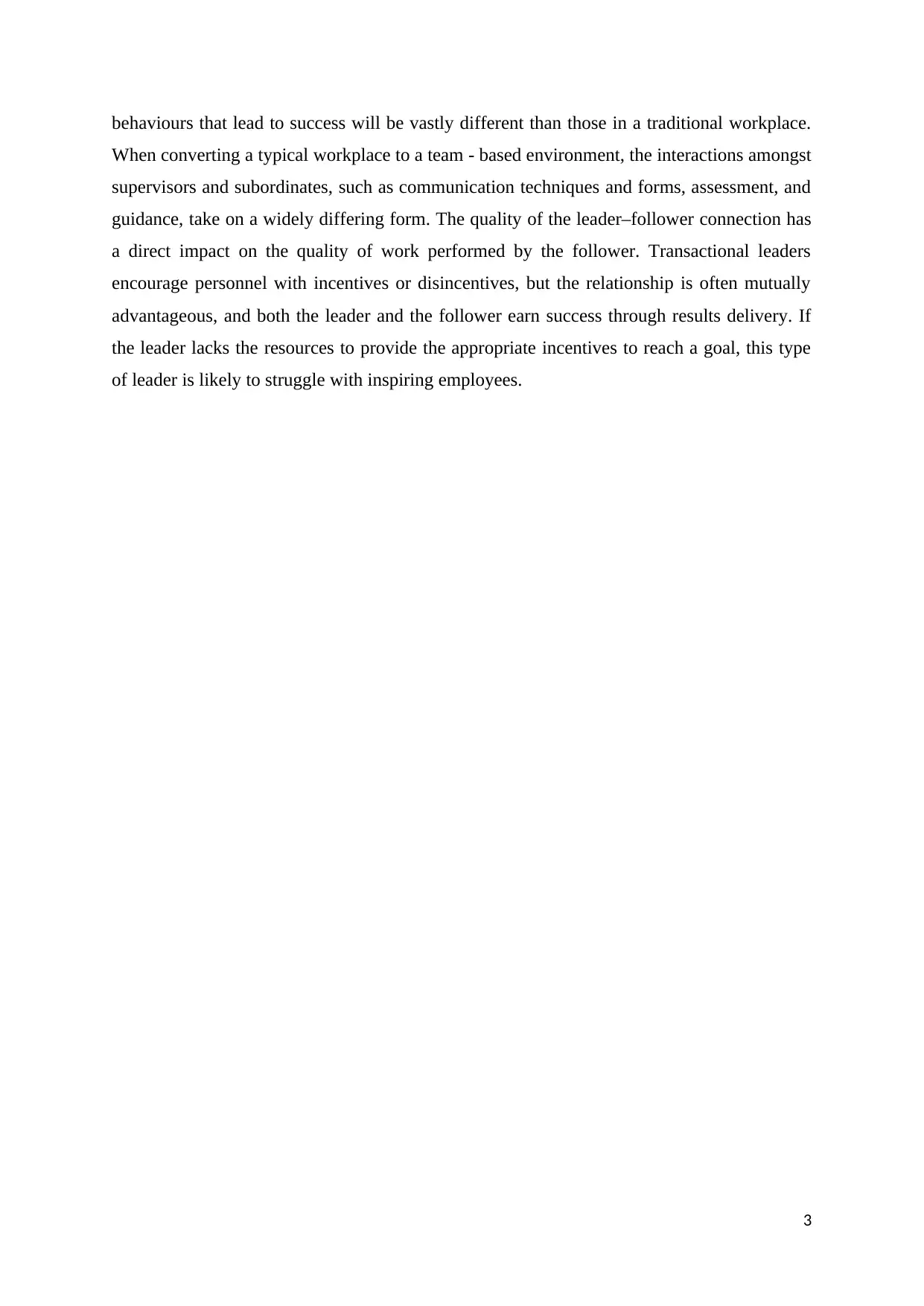
behaviours that lead to success will be vastly different than those in a traditional workplace.
When converting a typical workplace to a team - based environment, the interactions amongst
supervisors and subordinates, such as communication techniques and forms, assessment, and
guidance, take on a widely differing form. The quality of the leader–follower connection has
a direct impact on the quality of work performed by the follower. Transactional leaders
encourage personnel with incentives or disincentives, but the relationship is often mutually
advantageous, and both the leader and the follower earn success through results delivery. If
the leader lacks the resources to provide the appropriate incentives to reach a goal, this type
of leader is likely to struggle with inspiring employees.
3
When converting a typical workplace to a team - based environment, the interactions amongst
supervisors and subordinates, such as communication techniques and forms, assessment, and
guidance, take on a widely differing form. The quality of the leader–follower connection has
a direct impact on the quality of work performed by the follower. Transactional leaders
encourage personnel with incentives or disincentives, but the relationship is often mutually
advantageous, and both the leader and the follower earn success through results delivery. If
the leader lacks the resources to provide the appropriate incentives to reach a goal, this type
of leader is likely to struggle with inspiring employees.
3
⊘ This is a preview!⊘
Do you want full access?
Subscribe today to unlock all pages.

Trusted by 1+ million students worldwide
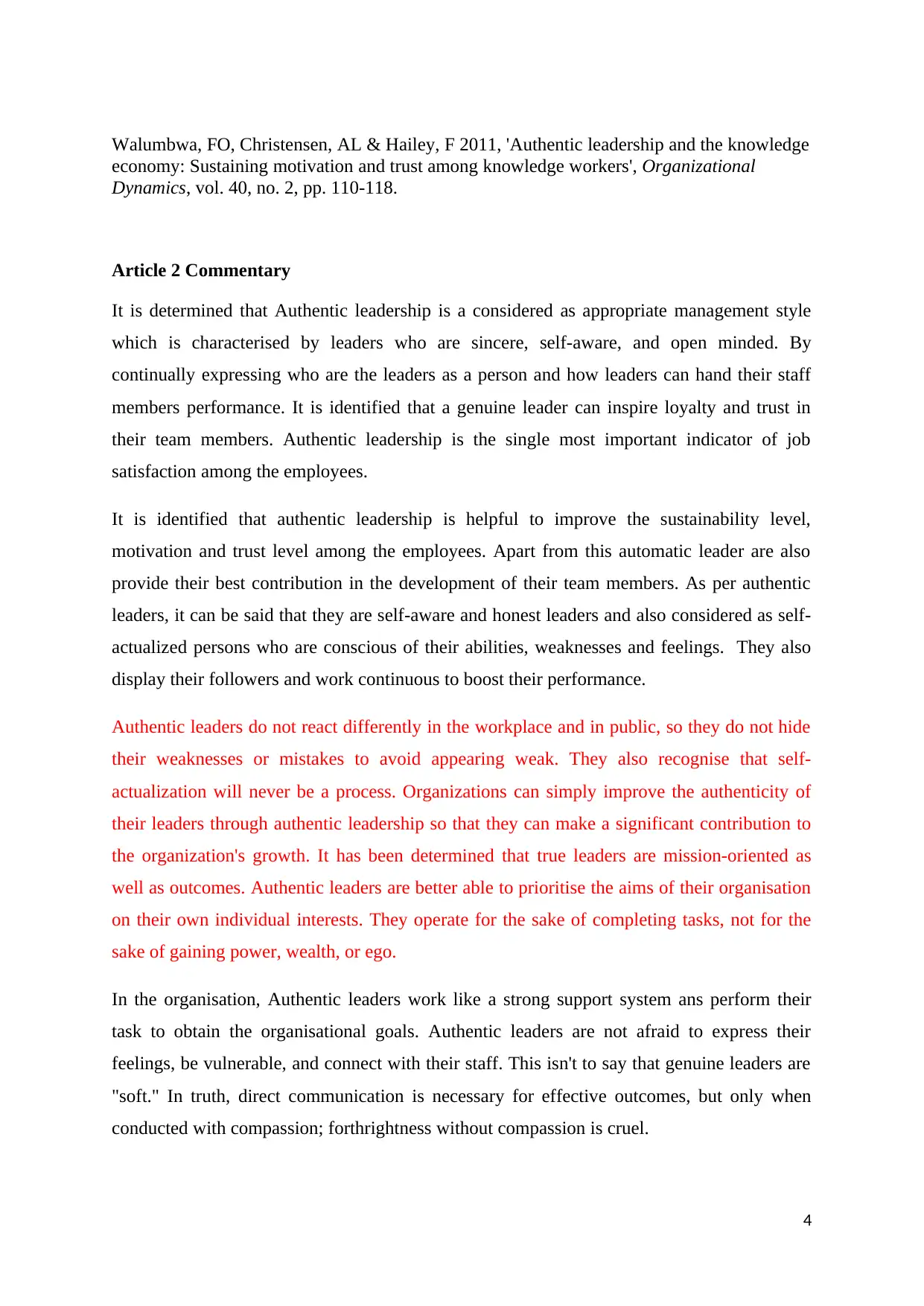
Walumbwa, FO, Christensen, AL & Hailey, F 2011, 'Authentic leadership and the knowledge
economy: Sustaining motivation and trust among knowledge workers', Organizational
Dynamics, vol. 40, no. 2, pp. 110-118.
Article 2 Commentary
It is determined that Authentic leadership is a considered as appropriate management style
which is characterised by leaders who are sincere, self-aware, and open minded. By
continually expressing who are the leaders as a person and how leaders can hand their staff
members performance. It is identified that a genuine leader can inspire loyalty and trust in
their team members. Authentic leadership is the single most important indicator of job
satisfaction among the employees.
It is identified that authentic leadership is helpful to improve the sustainability level,
motivation and trust level among the employees. Apart from this automatic leader are also
provide their best contribution in the development of their team members. As per authentic
leaders, it can be said that they are self-aware and honest leaders and also considered as self-
actualized persons who are conscious of their abilities, weaknesses and feelings. They also
display their followers and work continuous to boost their performance.
Authentic leaders do not react differently in the workplace and in public, so they do not hide
their weaknesses or mistakes to avoid appearing weak. They also recognise that self-
actualization will never be a process. Organizations can simply improve the authenticity of
their leaders through authentic leadership so that they can make a significant contribution to
the organization's growth. It has been determined that true leaders are mission-oriented as
well as outcomes. Authentic leaders are better able to prioritise the aims of their organisation
on their own individual interests. They operate for the sake of completing tasks, not for the
sake of gaining power, wealth, or ego.
In the organisation, Authentic leaders work like a strong support system ans perform their
task to obtain the organisational goals. Authentic leaders are not afraid to express their
feelings, be vulnerable, and connect with their staff. This isn't to say that genuine leaders are
"soft." In truth, direct communication is necessary for effective outcomes, but only when
conducted with compassion; forthrightness without compassion is cruel.
4
economy: Sustaining motivation and trust among knowledge workers', Organizational
Dynamics, vol. 40, no. 2, pp. 110-118.
Article 2 Commentary
It is determined that Authentic leadership is a considered as appropriate management style
which is characterised by leaders who are sincere, self-aware, and open minded. By
continually expressing who are the leaders as a person and how leaders can hand their staff
members performance. It is identified that a genuine leader can inspire loyalty and trust in
their team members. Authentic leadership is the single most important indicator of job
satisfaction among the employees.
It is identified that authentic leadership is helpful to improve the sustainability level,
motivation and trust level among the employees. Apart from this automatic leader are also
provide their best contribution in the development of their team members. As per authentic
leaders, it can be said that they are self-aware and honest leaders and also considered as self-
actualized persons who are conscious of their abilities, weaknesses and feelings. They also
display their followers and work continuous to boost their performance.
Authentic leaders do not react differently in the workplace and in public, so they do not hide
their weaknesses or mistakes to avoid appearing weak. They also recognise that self-
actualization will never be a process. Organizations can simply improve the authenticity of
their leaders through authentic leadership so that they can make a significant contribution to
the organization's growth. It has been determined that true leaders are mission-oriented as
well as outcomes. Authentic leaders are better able to prioritise the aims of their organisation
on their own individual interests. They operate for the sake of completing tasks, not for the
sake of gaining power, wealth, or ego.
In the organisation, Authentic leaders work like a strong support system ans perform their
task to obtain the organisational goals. Authentic leaders are not afraid to express their
feelings, be vulnerable, and connect with their staff. This isn't to say that genuine leaders are
"soft." In truth, direct communication is necessary for effective outcomes, but only when
conducted with compassion; forthrightness without compassion is cruel.
4
Paraphrase This Document
Need a fresh take? Get an instant paraphrase of this document with our AI Paraphraser
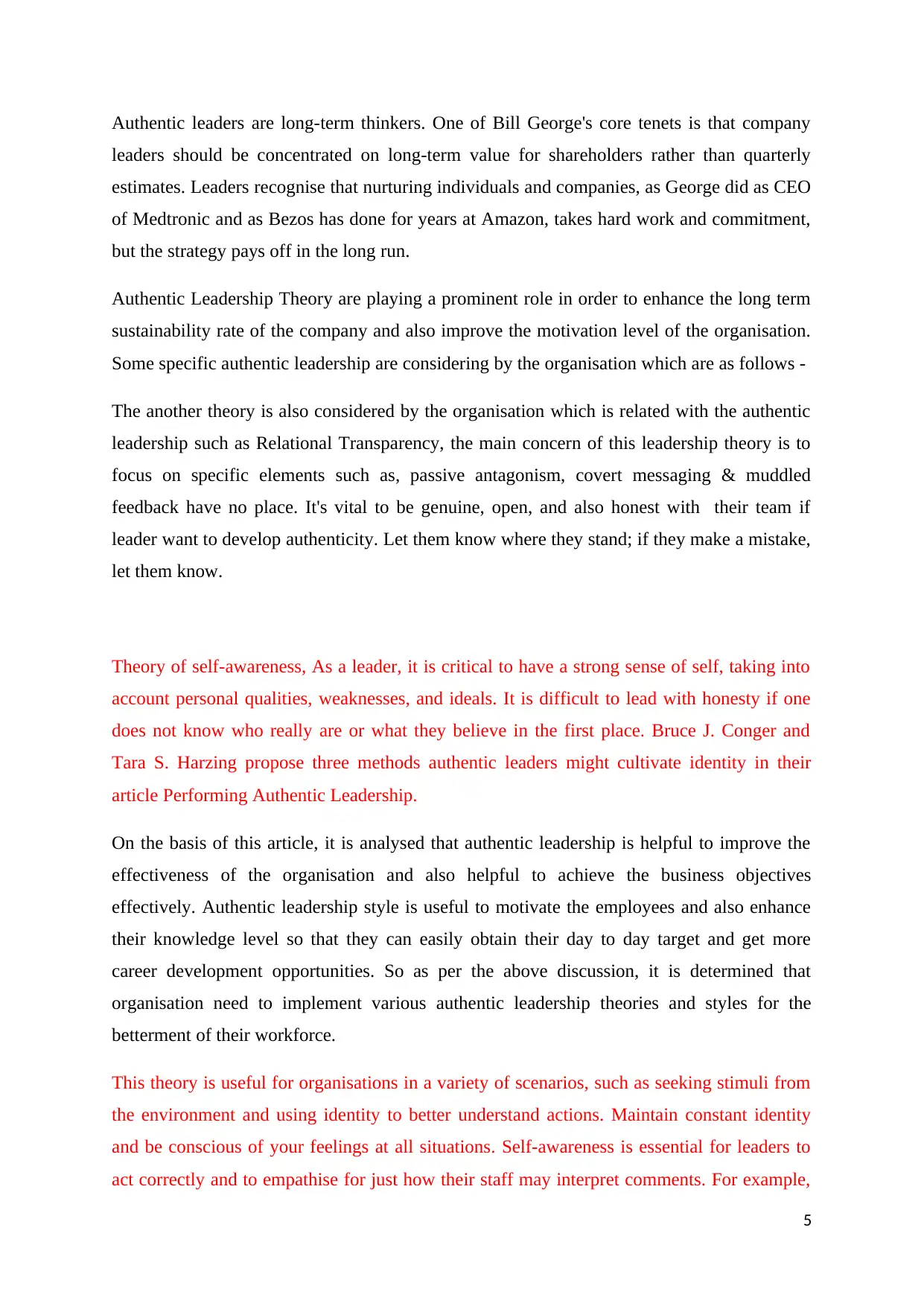
Authentic leaders are long-term thinkers. One of Bill George's core tenets is that company
leaders should be concentrated on long-term value for shareholders rather than quarterly
estimates. Leaders recognise that nurturing individuals and companies, as George did as CEO
of Medtronic and as Bezos has done for years at Amazon, takes hard work and commitment,
but the strategy pays off in the long run.
Authentic Leadership Theory are playing a prominent role in order to enhance the long term
sustainability rate of the company and also improve the motivation level of the organisation.
Some specific authentic leadership are considering by the organisation which are as follows -
The another theory is also considered by the organisation which is related with the authentic
leadership such as Relational Transparency, the main concern of this leadership theory is to
focus on specific elements such as, passive antagonism, covert messaging & muddled
feedback have no place. It's vital to be genuine, open, and also honest with their team if
leader want to develop authenticity. Let them know where they stand; if they make a mistake,
let them know.
Theory of self-awareness, As a leader, it is critical to have a strong sense of self, taking into
account personal qualities, weaknesses, and ideals. It is difficult to lead with honesty if one
does not know who really are or what they believe in the first place. Bruce J. Conger and
Tara S. Harzing propose three methods authentic leaders might cultivate identity in their
article Performing Authentic Leadership.
On the basis of this article, it is analysed that authentic leadership is helpful to improve the
effectiveness of the organisation and also helpful to achieve the business objectives
effectively. Authentic leadership style is useful to motivate the employees and also enhance
their knowledge level so that they can easily obtain their day to day target and get more
career development opportunities. So as per the above discussion, it is determined that
organisation need to implement various authentic leadership theories and styles for the
betterment of their workforce.
This theory is useful for organisations in a variety of scenarios, such as seeking stimuli from
the environment and using identity to better understand actions. Maintain constant identity
and be conscious of your feelings at all situations. Self-awareness is essential for leaders to
act correctly and to empathise for just how their staff may interpret comments. For example,
5
leaders should be concentrated on long-term value for shareholders rather than quarterly
estimates. Leaders recognise that nurturing individuals and companies, as George did as CEO
of Medtronic and as Bezos has done for years at Amazon, takes hard work and commitment,
but the strategy pays off in the long run.
Authentic Leadership Theory are playing a prominent role in order to enhance the long term
sustainability rate of the company and also improve the motivation level of the organisation.
Some specific authentic leadership are considering by the organisation which are as follows -
The another theory is also considered by the organisation which is related with the authentic
leadership such as Relational Transparency, the main concern of this leadership theory is to
focus on specific elements such as, passive antagonism, covert messaging & muddled
feedback have no place. It's vital to be genuine, open, and also honest with their team if
leader want to develop authenticity. Let them know where they stand; if they make a mistake,
let them know.
Theory of self-awareness, As a leader, it is critical to have a strong sense of self, taking into
account personal qualities, weaknesses, and ideals. It is difficult to lead with honesty if one
does not know who really are or what they believe in the first place. Bruce J. Conger and
Tara S. Harzing propose three methods authentic leaders might cultivate identity in their
article Performing Authentic Leadership.
On the basis of this article, it is analysed that authentic leadership is helpful to improve the
effectiveness of the organisation and also helpful to achieve the business objectives
effectively. Authentic leadership style is useful to motivate the employees and also enhance
their knowledge level so that they can easily obtain their day to day target and get more
career development opportunities. So as per the above discussion, it is determined that
organisation need to implement various authentic leadership theories and styles for the
betterment of their workforce.
This theory is useful for organisations in a variety of scenarios, such as seeking stimuli from
the environment and using identity to better understand actions. Maintain constant identity
and be conscious of your feelings at all situations. Self-awareness is essential for leaders to
act correctly and to empathise for just how their staff may interpret comments. For example,
5

leaders may believe that a chat they had with their organization was demoralising, or they
may have just received some discouraging news about their performance on the field and then
spoke out of irritation. It is vital to solicit feedback from the environment by addressing your
staff what you're doing to assist their in going forward.
6
may have just received some discouraging news about their performance on the field and then
spoke out of irritation. It is vital to solicit feedback from the environment by addressing your
staff what you're doing to assist their in going forward.
6
⊘ This is a preview!⊘
Do you want full access?
Subscribe today to unlock all pages.

Trusted by 1+ million students worldwide
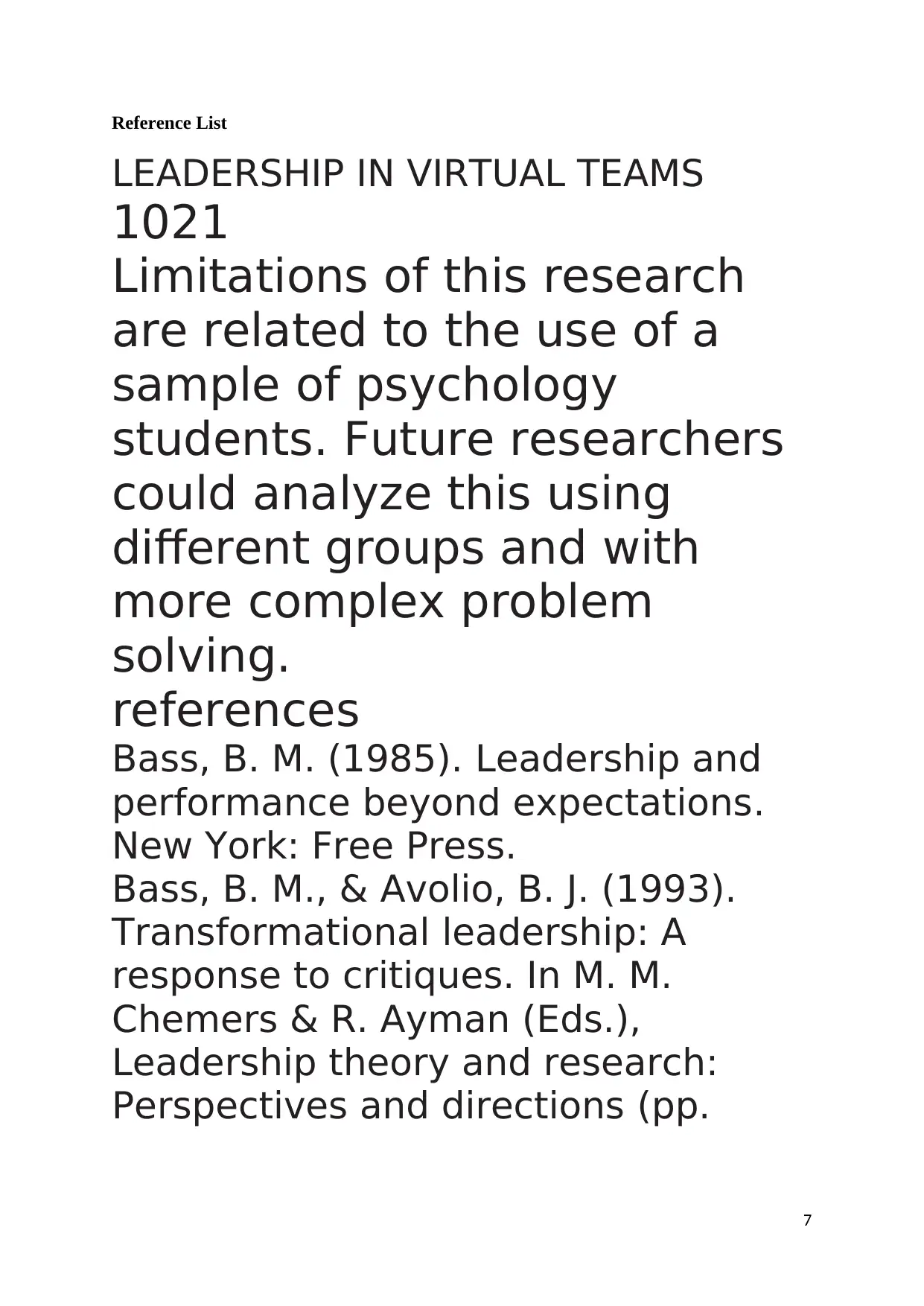
Reference List
LEADERSHIP IN VIRTUAL TEAMS
1021
Limitations of this research
are related to the use of a
sample of psychology
students. Future researchers
could analyze this using
different groups and with
more complex problem
solving.
references
Bass, B. M. (1985). Leadership and
performance beyond expectations.
New York: Free Press.
Bass, B. M., & Avolio, B. J. (1993).
Transformational leadership: A
response to critiques. In M. M.
Chemers & R. Ayman (Eds.),
Leadership theory and research:
Perspectives and directions (pp.
7
LEADERSHIP IN VIRTUAL TEAMS
1021
Limitations of this research
are related to the use of a
sample of psychology
students. Future researchers
could analyze this using
different groups and with
more complex problem
solving.
references
Bass, B. M. (1985). Leadership and
performance beyond expectations.
New York: Free Press.
Bass, B. M., & Avolio, B. J. (1993).
Transformational leadership: A
response to critiques. In M. M.
Chemers & R. Ayman (Eds.),
Leadership theory and research:
Perspectives and directions (pp.
7
Paraphrase This Document
Need a fresh take? Get an instant paraphrase of this document with our AI Paraphraser
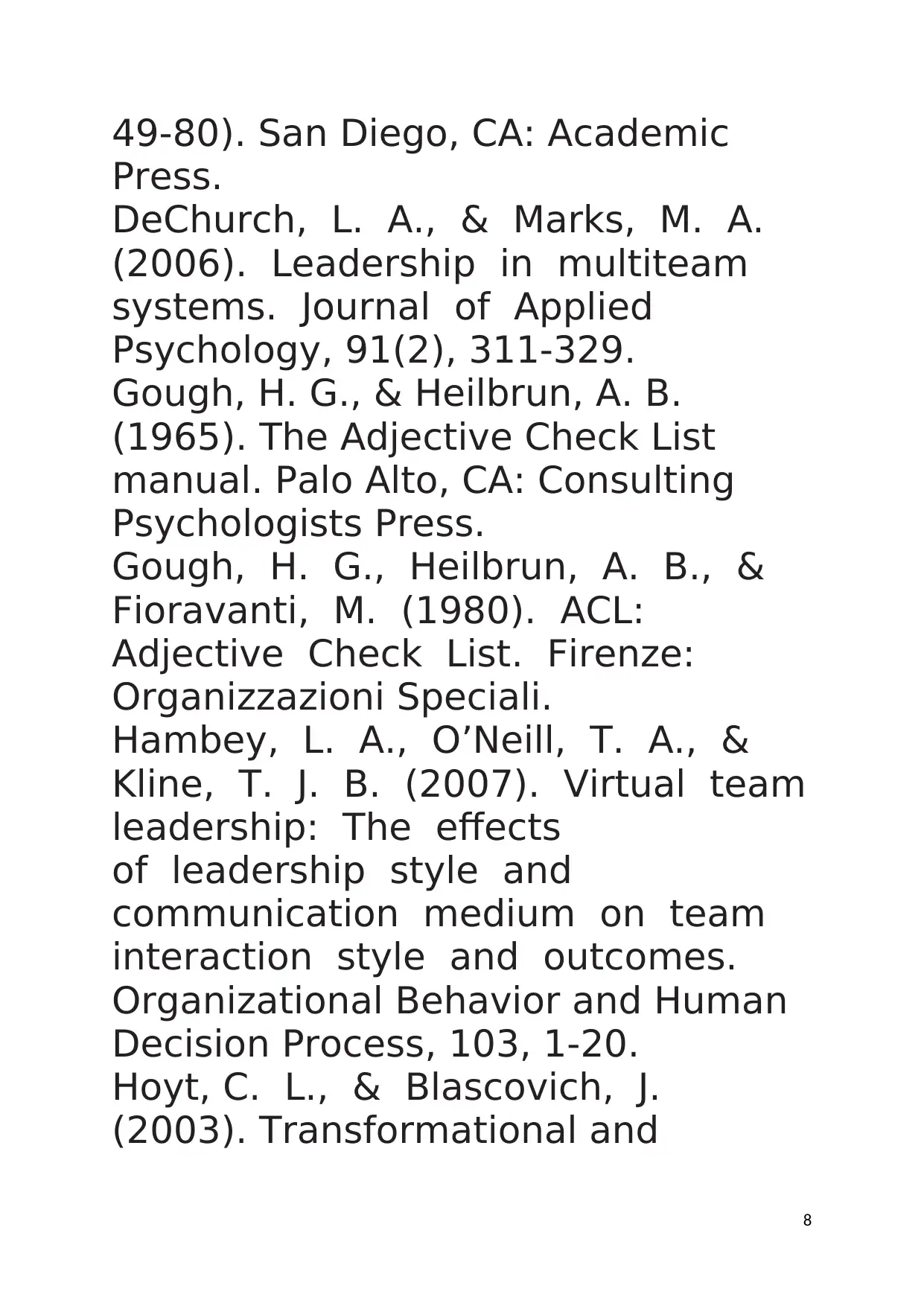
49-80). San Diego, CA: Academic
Press.
DeChurch, L. A., & Marks, M. A.
(2006). Leadership in multiteam
systems. Journal of Applied
Psychology, 91(2), 311-329.
Gough, H. G., & Heilbrun, A. B.
(1965). The Adjective Check List
manual. Palo Alto, CA: Consulting
Psychologists Press.
Gough, H. G., Heilbrun, A. B., &
Fioravanti, M. (1980). ACL:
Adjective Check List. Firenze:
Organizzazioni Speciali.
Hambey, L. A., O’Neill, T. A., &
Kline, T. J. B. (2007). Virtual team
leadership: The effects
of leadership style and
communication medium on team
interaction style and outcomes.
Organizational Behavior and Human
Decision Process, 103, 1-20.
Hoyt, C. L., & Blascovich, J.
(2003). Transformational and
8
Press.
DeChurch, L. A., & Marks, M. A.
(2006). Leadership in multiteam
systems. Journal of Applied
Psychology, 91(2), 311-329.
Gough, H. G., & Heilbrun, A. B.
(1965). The Adjective Check List
manual. Palo Alto, CA: Consulting
Psychologists Press.
Gough, H. G., Heilbrun, A. B., &
Fioravanti, M. (1980). ACL:
Adjective Check List. Firenze:
Organizzazioni Speciali.
Hambey, L. A., O’Neill, T. A., &
Kline, T. J. B. (2007). Virtual team
leadership: The effects
of leadership style and
communication medium on team
interaction style and outcomes.
Organizational Behavior and Human
Decision Process, 103, 1-20.
Hoyt, C. L., & Blascovich, J.
(2003). Transformational and
8
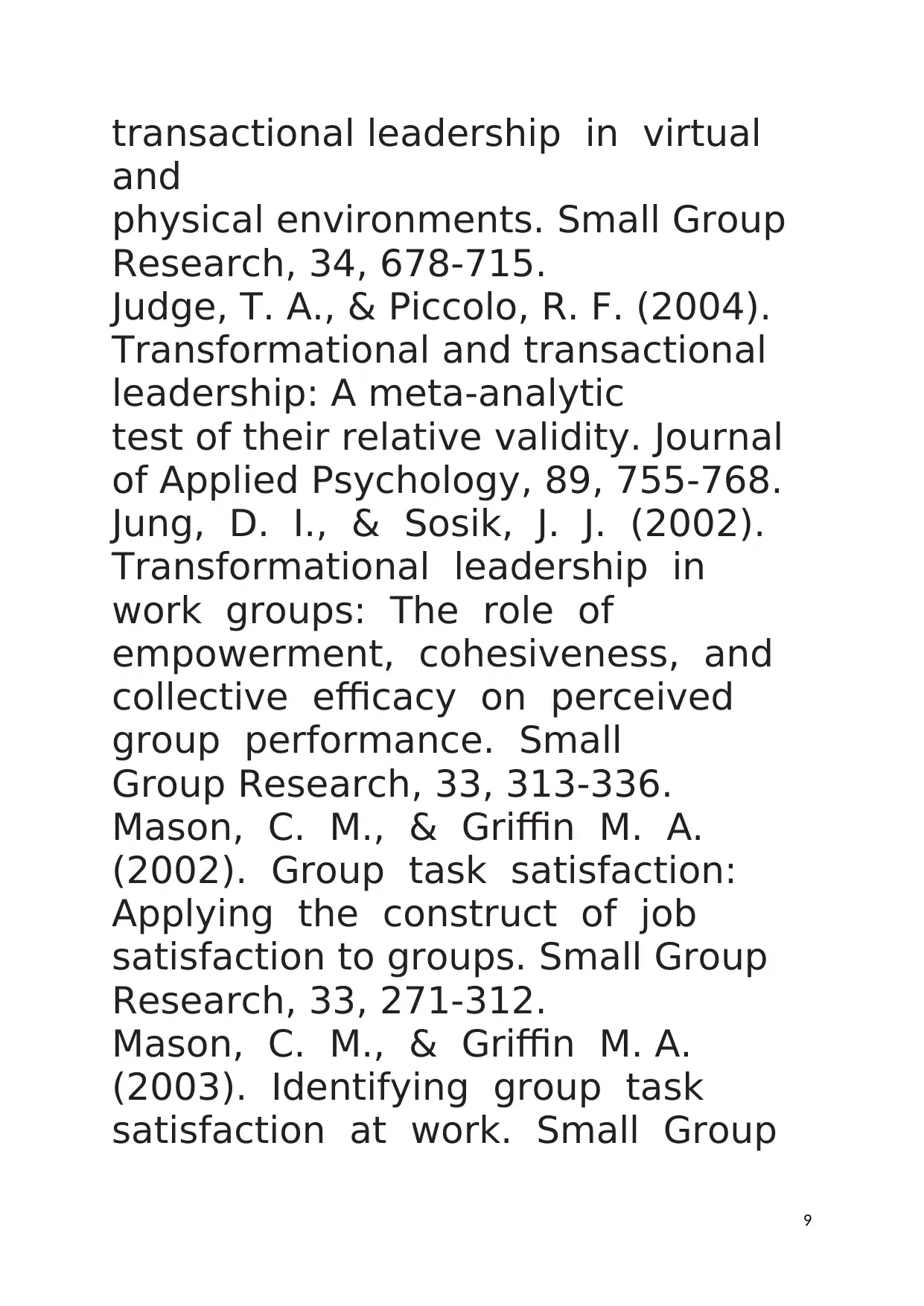
transactional leadership in virtual
and
physical environments. Small Group
Research, 34, 678-715.
Judge, T. A., & Piccolo, R. F. (2004).
Transformational and transactional
leadership: A meta-analytic
test of their relative validity. Journal
of Applied Psychology, 89, 755-768.
Jung, D. I., & Sosik, J. J. (2002).
Transformational leadership in
work groups: The role of
empowerment, cohesiveness, and
collective efficacy on perceived
group performance. Small
Group Research, 33, 313-336.
Mason, C. M., & Griffin M. A.
(2002). Group task satisfaction:
Applying the construct of job
satisfaction to groups. Small Group
Research, 33, 271-312.
Mason, C. M., & Griffin M. A.
(2003). Identifying group task
satisfaction at work. Small Group
9
and
physical environments. Small Group
Research, 34, 678-715.
Judge, T. A., & Piccolo, R. F. (2004).
Transformational and transactional
leadership: A meta-analytic
test of their relative validity. Journal
of Applied Psychology, 89, 755-768.
Jung, D. I., & Sosik, J. J. (2002).
Transformational leadership in
work groups: The role of
empowerment, cohesiveness, and
collective efficacy on perceived
group performance. Small
Group Research, 33, 313-336.
Mason, C. M., & Griffin M. A.
(2002). Group task satisfaction:
Applying the construct of job
satisfaction to groups. Small Group
Research, 33, 271-312.
Mason, C. M., & Griffin M. A.
(2003). Identifying group task
satisfaction at work. Small Group
9
⊘ This is a preview!⊘
Do you want full access?
Subscribe today to unlock all pages.

Trusted by 1+ million students worldwide
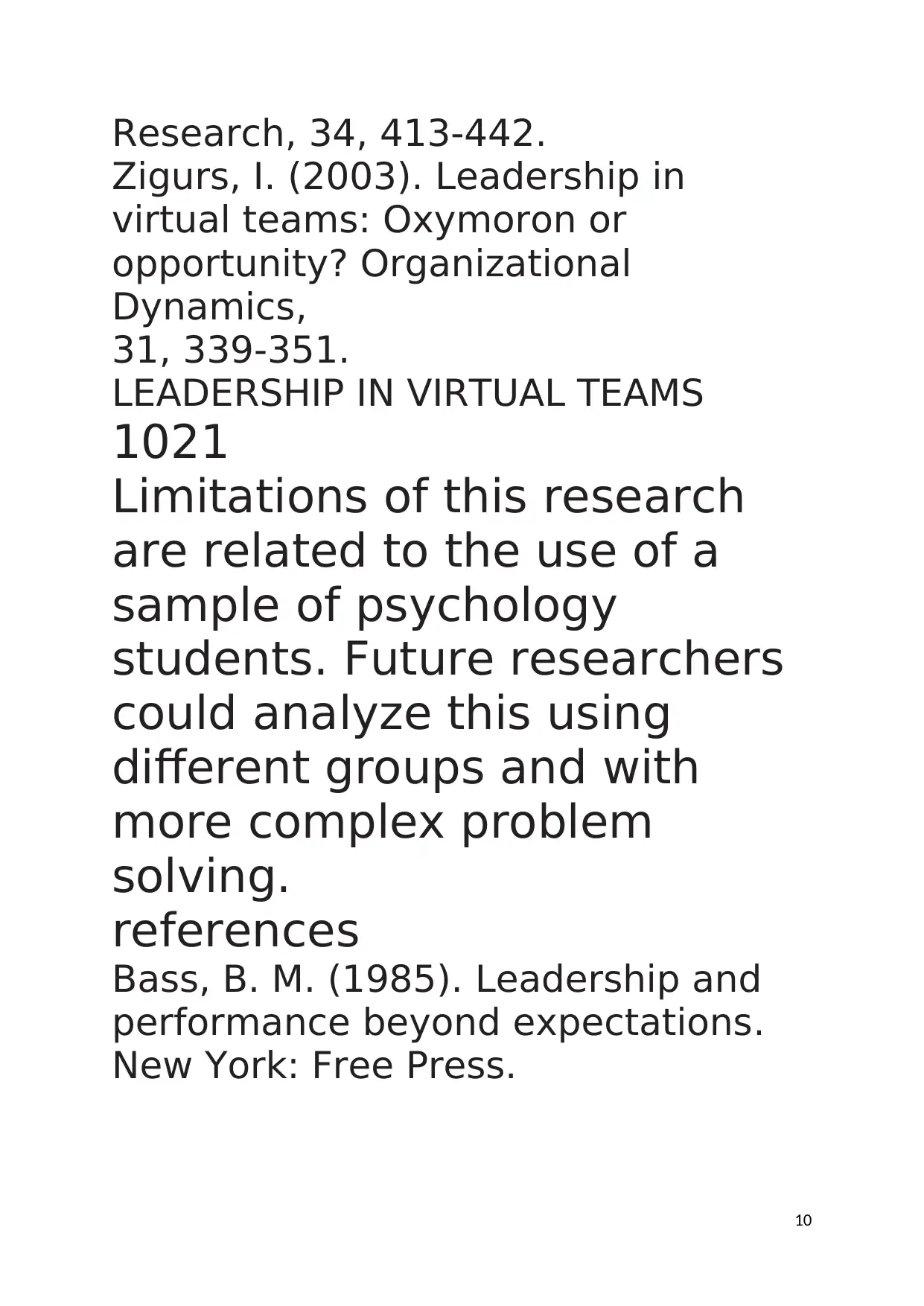
Research, 34, 413-442.
Zigurs, I. (2003). Leadership in
virtual teams: Oxymoron or
opportunity? Organizational
Dynamics,
31, 339-351.
LEADERSHIP IN VIRTUAL TEAMS
1021
Limitations of this research
are related to the use of a
sample of psychology
students. Future researchers
could analyze this using
different groups and with
more complex problem
solving.
references
Bass, B. M. (1985). Leadership and
performance beyond expectations.
New York: Free Press.
10
Zigurs, I. (2003). Leadership in
virtual teams: Oxymoron or
opportunity? Organizational
Dynamics,
31, 339-351.
LEADERSHIP IN VIRTUAL TEAMS
1021
Limitations of this research
are related to the use of a
sample of psychology
students. Future researchers
could analyze this using
different groups and with
more complex problem
solving.
references
Bass, B. M. (1985). Leadership and
performance beyond expectations.
New York: Free Press.
10
Paraphrase This Document
Need a fresh take? Get an instant paraphrase of this document with our AI Paraphraser
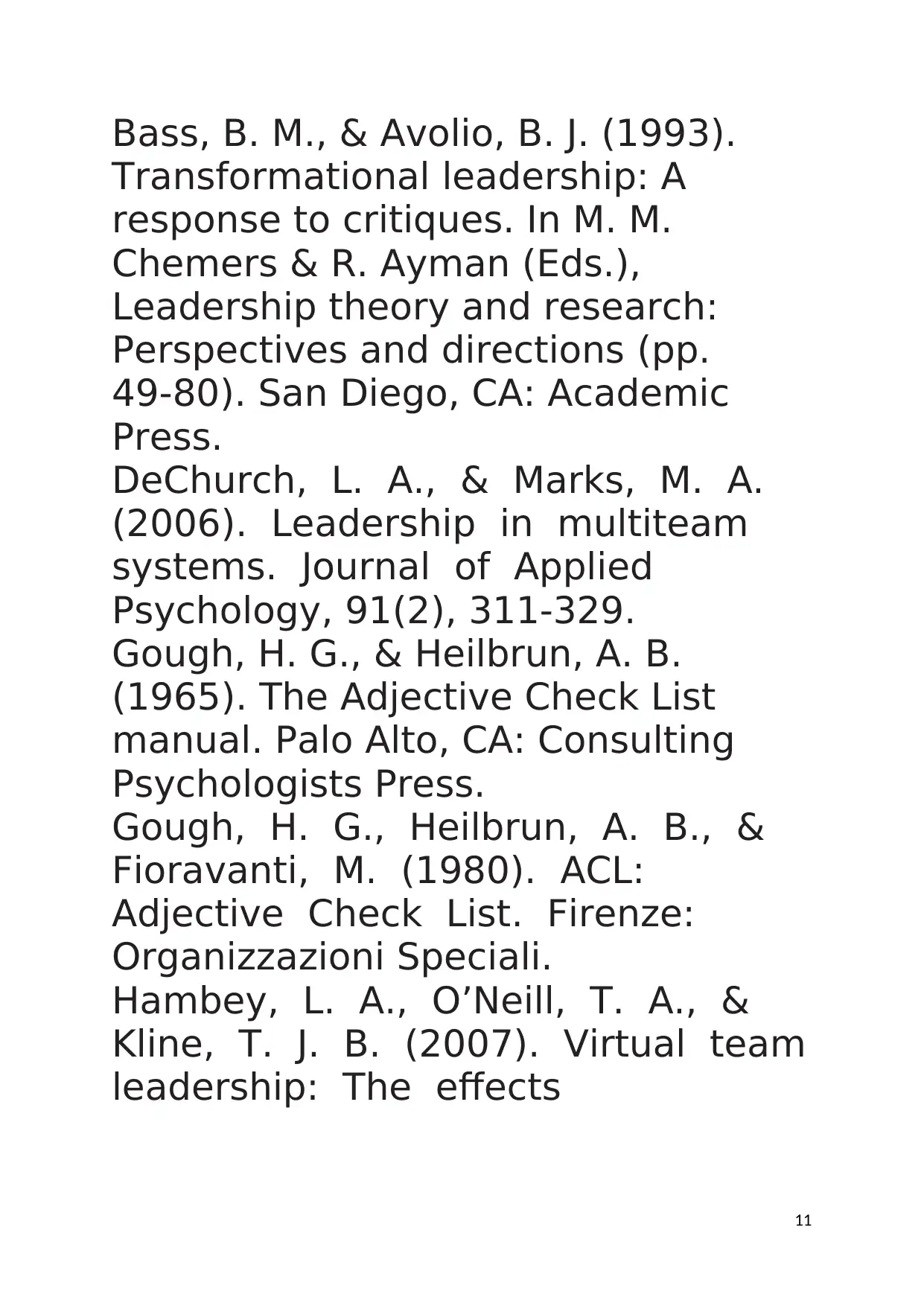
Bass, B. M., & Avolio, B. J. (1993).
Transformational leadership: A
response to critiques. In M. M.
Chemers & R. Ayman (Eds.),
Leadership theory and research:
Perspectives and directions (pp.
49-80). San Diego, CA: Academic
Press.
DeChurch, L. A., & Marks, M. A.
(2006). Leadership in multiteam
systems. Journal of Applied
Psychology, 91(2), 311-329.
Gough, H. G., & Heilbrun, A. B.
(1965). The Adjective Check List
manual. Palo Alto, CA: Consulting
Psychologists Press.
Gough, H. G., Heilbrun, A. B., &
Fioravanti, M. (1980). ACL:
Adjective Check List. Firenze:
Organizzazioni Speciali.
Hambey, L. A., O’Neill, T. A., &
Kline, T. J. B. (2007). Virtual team
leadership: The effects
11
Transformational leadership: A
response to critiques. In M. M.
Chemers & R. Ayman (Eds.),
Leadership theory and research:
Perspectives and directions (pp.
49-80). San Diego, CA: Academic
Press.
DeChurch, L. A., & Marks, M. A.
(2006). Leadership in multiteam
systems. Journal of Applied
Psychology, 91(2), 311-329.
Gough, H. G., & Heilbrun, A. B.
(1965). The Adjective Check List
manual. Palo Alto, CA: Consulting
Psychologists Press.
Gough, H. G., Heilbrun, A. B., &
Fioravanti, M. (1980). ACL:
Adjective Check List. Firenze:
Organizzazioni Speciali.
Hambey, L. A., O’Neill, T. A., &
Kline, T. J. B. (2007). Virtual team
leadership: The effects
11
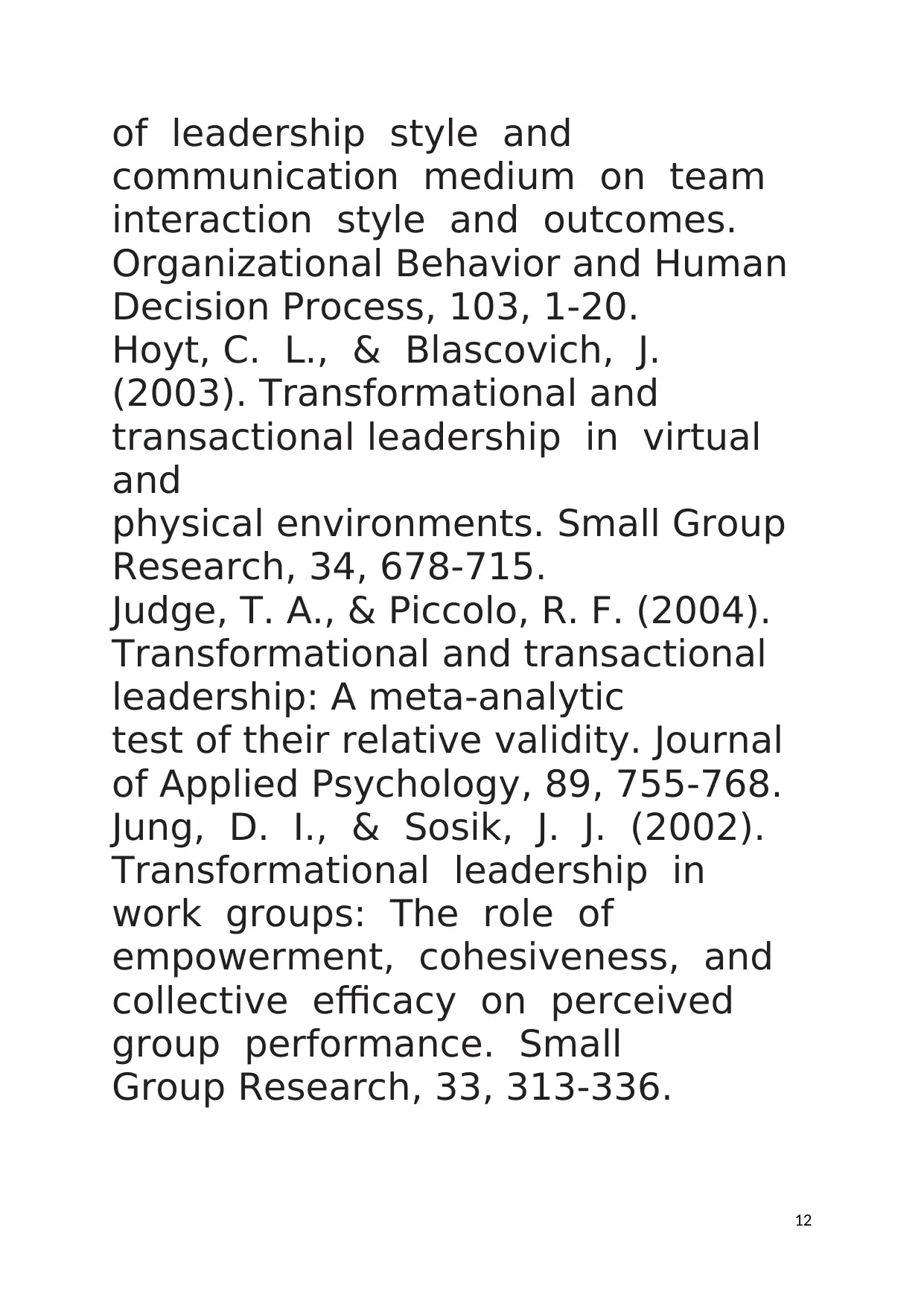
of leadership style and
communication medium on team
interaction style and outcomes.
Organizational Behavior and Human
Decision Process, 103, 1-20.
Hoyt, C. L., & Blascovich, J.
(2003). Transformational and
transactional leadership in virtual
and
physical environments. Small Group
Research, 34, 678-715.
Judge, T. A., & Piccolo, R. F. (2004).
Transformational and transactional
leadership: A meta-analytic
test of their relative validity. Journal
of Applied Psychology, 89, 755-768.
Jung, D. I., & Sosik, J. J. (2002).
Transformational leadership in
work groups: The role of
empowerment, cohesiveness, and
collective efficacy on perceived
group performance. Small
Group Research, 33, 313-336.
12
communication medium on team
interaction style and outcomes.
Organizational Behavior and Human
Decision Process, 103, 1-20.
Hoyt, C. L., & Blascovich, J.
(2003). Transformational and
transactional leadership in virtual
and
physical environments. Small Group
Research, 34, 678-715.
Judge, T. A., & Piccolo, R. F. (2004).
Transformational and transactional
leadership: A meta-analytic
test of their relative validity. Journal
of Applied Psychology, 89, 755-768.
Jung, D. I., & Sosik, J. J. (2002).
Transformational leadership in
work groups: The role of
empowerment, cohesiveness, and
collective efficacy on perceived
group performance. Small
Group Research, 33, 313-336.
12
⊘ This is a preview!⊘
Do you want full access?
Subscribe today to unlock all pages.

Trusted by 1+ million students worldwide
1 out of 17
Related Documents
Your All-in-One AI-Powered Toolkit for Academic Success.
+13062052269
info@desklib.com
Available 24*7 on WhatsApp / Email
![[object Object]](/_next/static/media/star-bottom.7253800d.svg)
Unlock your academic potential
Copyright © 2020–2025 A2Z Services. All Rights Reserved. Developed and managed by ZUCOL.





